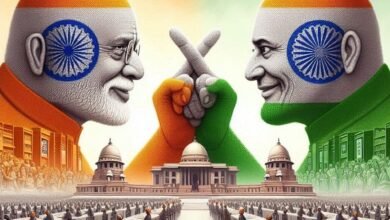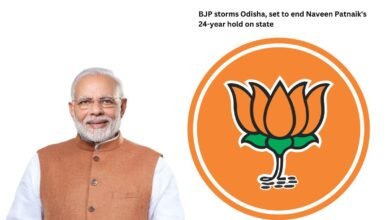Election Result 2024 | Comeback of Samajwadi Party in Uttar Pradesh

The election result of SP in 2024 marked a significant turning point in Uttar Pradesh’s political landscape. The Samajwadi Party, often abbreviated as SP, made a remarkable comeback, demonstrating the enduring strength and resilience of the party. This article delves into the details of this political resurgence, examining the factors that contributed to the SP’s victory and the implications for the future of Uttar Pradesh.
The Samajwadi Party’s Triumph
In the heart of India’s most populous state, a political drama unfolded as the Samajwadi Party emerged victorious in the 2024 elections. The party’s win was not just a testament to its robust campaign strategy and the charisma of its leaders, but also a reflection of the changing political dynamics in Uttar Pradesh.
Stay with us as we take you through this exciting journey of political resurgence, analyzing the strategies, the key players, and the impact of this comeback on the state’s future. Whether you’re a political enthusiast or a curious reader, this comprehensive coverage of the Samajwadi Party’s election result promises to keep you engaged.
Background of the Samajwadi Party
The Samajwadi Party (SP), translated as the Socialist Party, was founded on October 4, 1992. The party was established by Mulayam Singh Yadav, a seasoned politician who had previously been a part of the Janata Dal. The SP is currently led by Akhilesh Yadav, Mulayam Singh Yadav’s son, who has served as the Chief Minister of Uttar Pradesh.
The SP’s ideology is rooted in democratic socialism, populism, and social conservatism. The party has always aimed to create a socialist society that operates on the principle of equality. It has consistently sought to mobilize the state’s minority Muslim population and members of lower castes, notably those officially classified as Other Backward Classes (OBCs), into a political force.
The party’s political fortunes have seen several peaks and valleys. In December 1993, about a year after it had been established, the SP formed a coalition government in Uttar Pradesh with the support of the Bahujan Samaj Party (BSP). The party’s support base, which includes key voters from other backward classes and Muslims, helped the SP become a major political force in Uttar Pradesh.
In terms of electoral performance, the SP registered its best performance in the Lok Sabha elections in 2024, winning or leading on 37 of the 80 seats in Uttar Pradesh. This was a significant improvement from the 2019 elections, where the party won only 5 seats. The party’s strike rate was the highest among the bigger parties, winning or leading on 37 of the 62 seats it contested.
The SP’s previous best performance was in 2004 when it won 35 seats while Mulayam Singh Yadav was the Chief Minister of Uttar Pradesh. Despite being out of power for seven years, the party managed to improve its tally. The SP increased its vote share to 33.38% in 2024, compared to 18.11% in 2019.
In the 2022 Uttar Pradesh assembly polls, the SP improved its vote share to 32.1%. Its tally of seats also went up to 111 from 47 in 2017. In 2022, the SP began expanding its base beyond its Muslim-Yadav vote bank to stitch together a caste coalition of non-Yadav Other Backward Classes (OBC), Yadavs, Dalits, and Muslims.
The party’s journey has been marked by resilience and adaptability, and its comeback in the 2024 elections is a testament to its enduring strength and appeal among the masses.
The 2024 Election Campaign
The 2024 election campaign of the Samajwadi Party was a testament to the party’s resilience and adaptability. Led by Akhilesh Yadav, the party ran a spirited campaign, addressing key issues that resonated with the populace.
The Samajwadi Party’s campaign strategy was rooted in its commitment to social justice and equity. The party’s manifesto, titled ‘Janta Ka Maang Patra – Humara Adhikar’, promised a caste-based census by 2025 to ensure justice and equity for all. This was a significant move, considering the diverse social fabric of Uttar Pradesh.
In addition to the caste census, the manifesto included promises like a legal guarantee to Minimum Support Price (MSP) for farmers based on the Swaminathan formula, women’s reservation, free education, and the establishment of a Smart Village Cluster Development Authority. The party also pledged to end the ‘Agnipath’ scheme and resume regular recruitment in the armed forces.
The campaign addressed widespread dissatisfaction among the populace, pointing to issues such as inflation, unemployment, and agrarian distress as key concerns. The party’s commitment to addressing these issues played a significant role in its comeback.
Akhilesh Yadav, the party supremo, appealed to the party workers, office bearers, and candidates to remain vigilant and not get misled by the exit polls. This showed the party’s determination to stay focused on the campaign’s objectives and not be swayed by predictions and speculations.
The Samajwadi Party’s campaign was not just about promises and pledges; it was about connecting with the people, understanding their concerns, and offering solutions. The party’s success in the 2024 elections is a testament to the effectiveness of this approach.
Key Contenders in the 2024 Elections
The 2024 elections in Uttar Pradesh saw a number of key contenders who played significant roles in shaping the election results. Among them, two figures stood out – Akhilesh Yadav and his wife Dimple Yadav.
Akhilesh Yadav, the party supremo, contested from Uttar Pradesh’s Kannauj Lok Sabha constituency. His leadership and charisma were instrumental in leading the Samajwadi Party to a remarkable comeback in the 2024 elections. Akhilesh Yadav’s victory in Kannauj was a significant win for the party, marking his successful return to a seat that has been a family bastion.
Dimple Yadav, on the other hand, contested from the Mainpuri constituency. Her victory marked a continuation of the Yadav family’s strong presence in the constituency. Dimple Yadav’s win in Mainpuri was a testament to her popularity and the trust that the electorate placed in her.
Other key contenders from the Samajwadi Party included Rambhual Nishad from Sultanpur, Harendra Singh Malik from Muzaffarnagar, and Lalji Verma from Ambedkar Nagar. Their victories contributed to the overall success of the Samajwadi Party in the 2024 elections.
The impact of these key contenders on the election results was significant. Their victories not only contributed to the Samajwadi Party’s overall performance but also signaled a shift in Uttar Pradesh’s political landscape.
Election Results Overview
The 2024 elections in Uttar Pradesh were a turning point in the state’s political landscape. The Samajwadi Party, led by Akhilesh Yadav, made a remarkable comeback, winning 37 seats. This was a significant improvement from the 2019 elections, where the party won only 5 seats.
The BJP-led NDA, which was projected to win by a landslide, secured 35 seats. This was a setback for the party, which had won 62 seats in the 2019 elections. The Rashtriya Lok Dal and Apna Dal, NDA alliance partners, were ahead in two key seats of Western Uttar Pradesh.
| Party Name | Number of Seats Won |
|---|---|
| Samajwadi Party (SP) | 37 |
| Bharatiya Janata Party (BJP) | 33 |
| Congress | 7 |
| Rashtriya Lok Dal (RLD) | 2 |
| Apna Dal (Soneylal) (ADAL) | 1 |
| Aazad Samaj Party (Kanshi Ram) (ASPKR) | 1 |
The Congress party, which was part of the Opposition INDIA bloc along with the Samajwadi Party, won 7 seats. This was a significant improvement for the party, which had won only one seat in the 2019 elections.
Among the prominent leaders who took comfortable leads over their rivals were Prime Minister Narendra Modi in Varanasi, Defence Minister Rajnath Singh in Lucknow, Samajwadi Party chief Akhilesh Yadav and his wife Dimple Yadav in Kannauj and Mainpuri, and Congress candidates Rahul Gandhi and Kishori Lal Sharma in Rae Bareli and Amethi.
The election results reflect the changing political dynamics in Uttar Pradesh. The Samajwadi Party’s comeback signifies a shift in the electorate’s preferences and the effectiveness of the party’s campaign strategy
The Young Faces of Samajwadi Party
The 2024 elections saw the emergence of young leaders in the Samajwadi Party who have brought a refreshing change to the traditional perception of a politician. These young leaders, all under 30, are well-educated, articulate, and bring novel perspectives to their roles as lawmakers.
Pushpendra Saroj, 25, is one of the youngest Lok Sabha members. With degrees in accounting and management from Queen Mary University of London, he ran for Kaushambhi on a Samajwadi Party ticket and won by 1.03 lakh votes. He defeated Vinod Sonkar, a two-term BJP member of Parliament. His victory signifies a shift in the political dynamics of the region and brings a fresh perspective to the party.
Iqra Hasan, a 27-year-old Samajwadi Party candidate, won the Kairana seat with a margin of 69,116 votes. She graduated from the University of London’s School of Oriental and African Studies with a postgraduate degree in international law. Her victory is a testament to her popularity and the trust that the electorate placed in her.
Priya Saroj, a 25-year-old lawyer for the Supreme Court, made a triumphant electoral debut on the SP ticket, garnering 35,850 votes to win the Machhlishahr seat. She is Tufani Saroj’s daughter, the former MP. Her victory marks the rise of a new generation of leaders in the Samajwadi Party.
These young leaders represent the future of the Samajwadi Party. Their victories not only contributed to the overall success of the party in the 2024 elections but also signaled a shift in Uttar Pradesh’s political landscape. Their impact on the party’s future will be interesting to watch as they bring their unique perspectives and fresh ideas to the table.
Impact of the Samajwadi Party’s Comeback
The Samajwadi Party’s comeback in the 2024 elections has significant political implications for Uttar Pradesh and the broader Indian political landscape.
The party’s victory signals a shift in the electorate’s preferences, reflecting widespread dissatisfaction among the populace. The Samajwadi Party’s campaign addressed key issues such as inflation, unemployment, and agrarian distress, which resonated with the voters.
The party’s success in the 2024 elections is also a testament to its effective campaign strategy. The Samajwadi Party managed to woo non-Yadav Other Backward Classes (OBCs), who constitute about 35% of the population. This was a significant move, considering the diverse social fabric of Uttar Pradesh.
Looking ahead, the Samajwadi Party has ambitious plans for the future. The party’s manifesto for the 2024 elections includes promises like a caste census, a legal guarantee to Minimum Support Price (MSP) for farmers based on the Swaminathan formula, women’s reservation, free education, and the establishment of a Smart Village Cluster Development Authority.
The party also plans to end the ‘Agnipath’ scheme and resume regular recruitment in the armed forces. These initiatives reflect the party’s commitment to social justice and equity.
Conclusion
In conclusion, the Samajwadi Party’s comeback in the 2024 elections is a significant development in Uttar Pradesh’s political landscape. It reflects the changing political dynamics in the state and sets the stage for an interesting political future. As we look forward to the unfolding of this new political chapter, one thing is clear – the Samajwadi Party’s comeback has redefined the political narrative in Uttar Pradesh.



